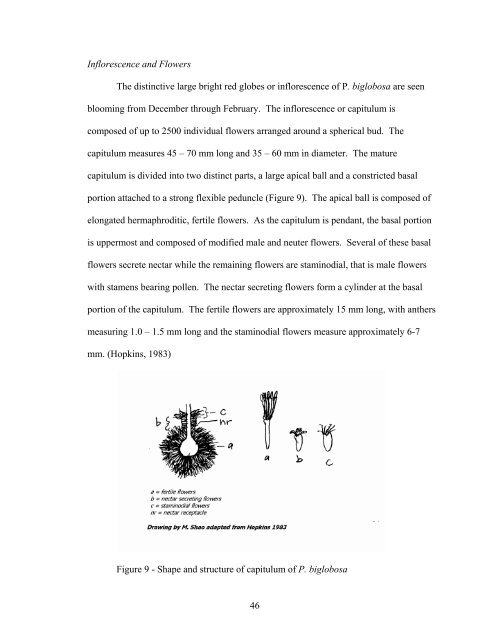i Parkia biglobosa - School of Forest Resources & Environmental ...
i Parkia biglobosa - School of Forest Resources & Environmental ...
i Parkia biglobosa - School of Forest Resources & Environmental ...
Create successful ePaper yourself
Turn your PDF publications into a flip-book with our unique Google optimized e-Paper software.
Inflorescence and Flowers<br />
The distinctive large bright red globes or inflorescence <strong>of</strong> P. <strong>biglobosa</strong> are seen<br />
blooming from December through February. The inflorescence or capitulum is<br />
composed <strong>of</strong> up to 2500 individual flowers arranged around a spherical bud. The<br />
capitulum measures 45 – 70 mm long and 35 – 60 mm in diameter. The mature<br />
capitulum is divided into two distinct parts, a large apical ball and a constricted basal<br />
portion attached to a strong flexible peduncle (Figure 9). The apical ball is composed <strong>of</strong><br />
elongated hermaphroditic, fertile flowers. As the capitulum is pendant, the basal portion<br />
is uppermost and composed <strong>of</strong> modified male and neuter flowers. Several <strong>of</strong> these basal<br />
flowers secrete nectar while the remaining flowers are staminodial, that is male flowers<br />
with stamens bearing pollen. The nectar secreting flowers form a cylinder at the basal<br />
portion <strong>of</strong> the capitulum. The fertile flowers are approximately 15 mm long, with anthers<br />
measuring 1.0 – 1.5 mm long and the staminodial flowers measure approximately 6-7<br />
mm. (Hopkins, 1983)<br />
Figure 9 - Shape and structure <strong>of</strong> capitulum <strong>of</strong> P. <strong>biglobosa</strong><br />
46








